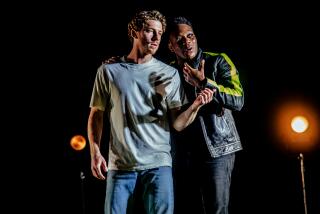The Romanovs’ ‘Russian Hamlet’
- Share via
A melancholy prince. A murdered king’s ghost. A play exposing his killer. Plots and counter-plots by the ruthlessly powerful. We’ve met these characters and situations before--but not they way they look in Boris Eifman’s “Russian Hamlet.”
Based on history but with a distinctive contemporary edge, this two-act ballet isn’t a Shakespearean tragedy about ancient Denmark, but a parallel chronicle of the crime-haunted house of Romanov in the 18th century.
Over the weekend at the Orange County Performing Arts Center, the Eifman Ballet of St. Petersburg fielded a new generation of Russian stars in this consummately audacious neo-Expressionist dance-drama, supporting Eifman’s talent for grand-scale pictorial splendor with performances of remarkable virtuosity, passion and depth.
In a skewed, palatial rotunda designed by Slava Okunev, the story of Czar Peter III, Catherine the Great and the tortured youth who became Paul I is danced to the unlikeliest of ballet music (on tape): all Beethoven in the plot-driven first act, mostly Mahler in the more hallucinatory Act 2.
Eifman summarizes events with great speed, boldness and theatrical flair, sometimes snarling his dancers in enormous bolts of fabric to symbolize the entanglements of the Romanov court, elsewhere flinging them from people-towers and the rotunda balcony to dramatize their high-risk power struggles.
In choreographic style as in accompaniment, “Russian Hamlet” (1999) proves more unified than Eifman’s “Red Giselle” of 1997, seen at the Universal Amphitheatre a year ago. As before, the core vocabulary is classical, but traditional ballet phrasing has now been fractured and the components reassembled in startling new movement patterns.
*
Conventional flowing transitions are gone, replaced by sharp, unexpected junctions where ballet steps, gymnastic feats and expressive gestures are spliced together to convey the social pretense and volatile emotions of the radically dysfunctional family on view.
Eifman can deliver swoony lyricism where necessary--as in a love duet to the “Moonlight Sonata,” danced mostly in silhouette behind a gleaming swath of silken blue cloth. Mostly, however, he opts for deliberately off-kilter confrontational episodes offset by dynamic social panoramas.
You might argue that the local color becomes excessive--that there’s at least one march too many in “Russian Hamlet,” and one too many “Spartacus”-style orgies as well. But Eifman’s biggest problem involves the gymnastic overkill in his intimate duets: The bravura feats often eclipse his dramatic purposes, weakening the audience’s involvement with the characters.
This problem looms largest in the scenes between Catherine and Paul--very, very showy in positional imagery and technical challenges, but far less feelingly conceived than the parallel moments of maternal rejection in Kenneth MacMillan’s “Mayerling” and Matthew Bourne’s “Swan Lake.”
As a creator of star roles, however, Eifman takes a back seat to no one: Like “Red Giselle,” this Romanov saga (originally choreographed for the Bolshoi) offers abundant opportunities for unique interpretive statements.
Catherine, for instance, can be an unshakably regal power-icon, as Yelena Kuzmina’s performance persuasively argued on Friday. Or she can be more conflicted and easier to manipulate, growing to a state of clenched isolation, as the imaginative and commanding Vera Arbuzova chose to depict her at the Saturday matinee.
*
Similarly, Paul can be a perpetually agonized royal misfit (a deft but under-energized Igor Markov on Friday). Or he can be a likable youth progressively warped by circumstance until he becomes genuinely dangerous and then conscience-stricken (the rougher but always impressive Yuri Smekalov the following afternoon).
Both Markov and Smekalov end up sobbing on the train of Catherine’s long, golden cloak--dragged along behind her to what will be Paul’s own eventual murder after the ballet ends. But nearly every moment of these performances differed in approach and effect.
The Eifman Ballet also boasts many other major dancing actors, including Alina Solonskaya and Natalia Pozdniakova (Paul’s ambitious and doomed first wife), Alexander Rachinsky and Oleg Markov (his father’s brutal ghost) and Albert Galichanin (Catherine’s feral, predatory lover). Together they bridge Russian Romanticism and contemporary dance with thrilling force and surety.
More to Read
The biggest entertainment stories
Get our big stories about Hollywood, film, television, music, arts, culture and more right in your inbox as soon as they publish.
You may occasionally receive promotional content from the Los Angeles Times.










